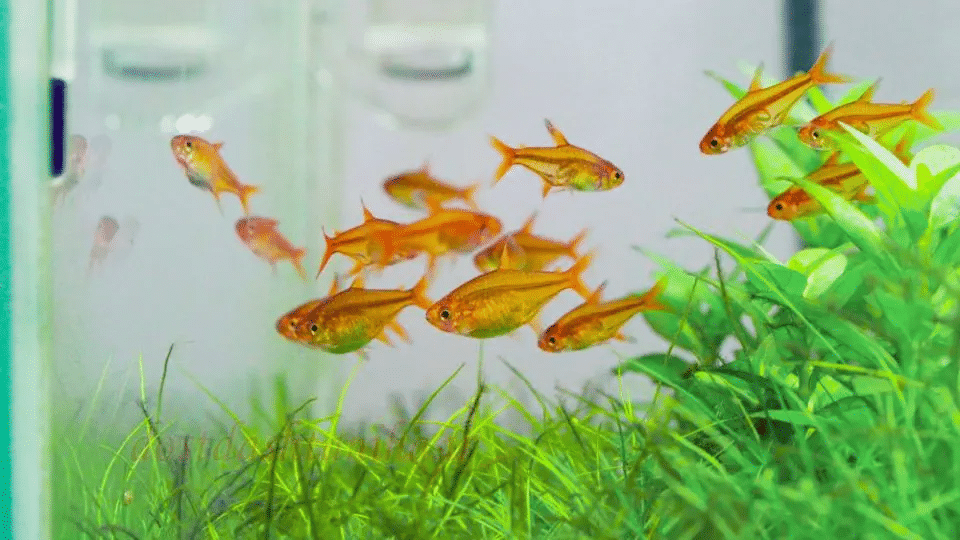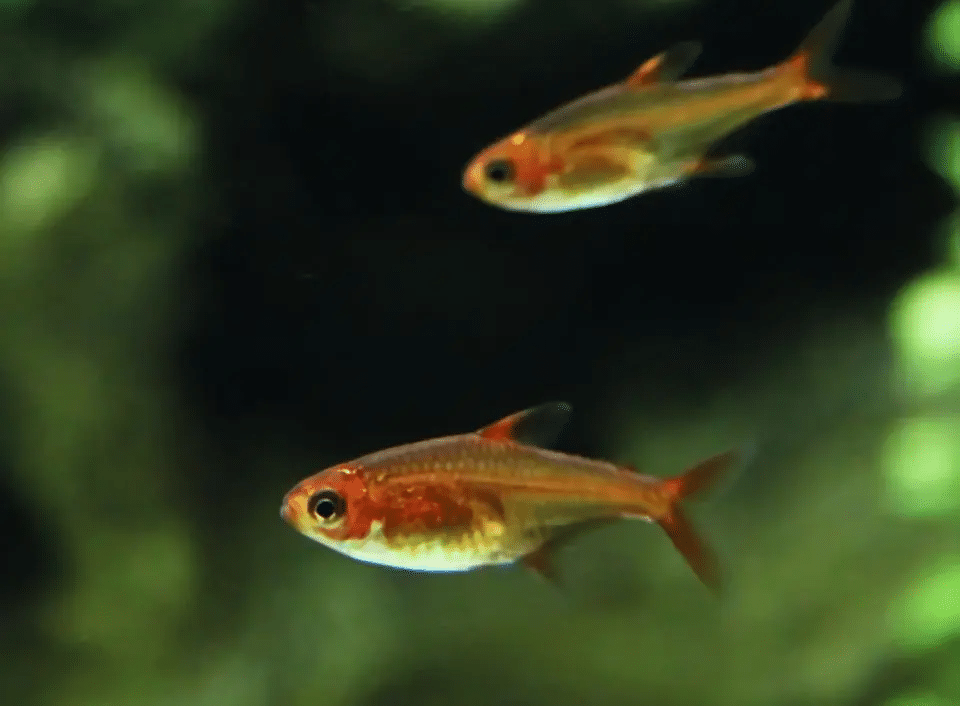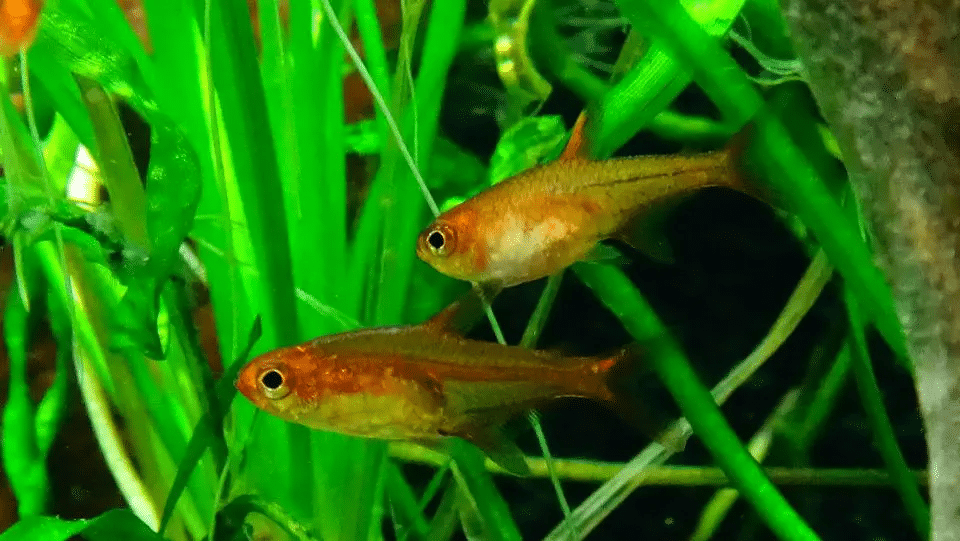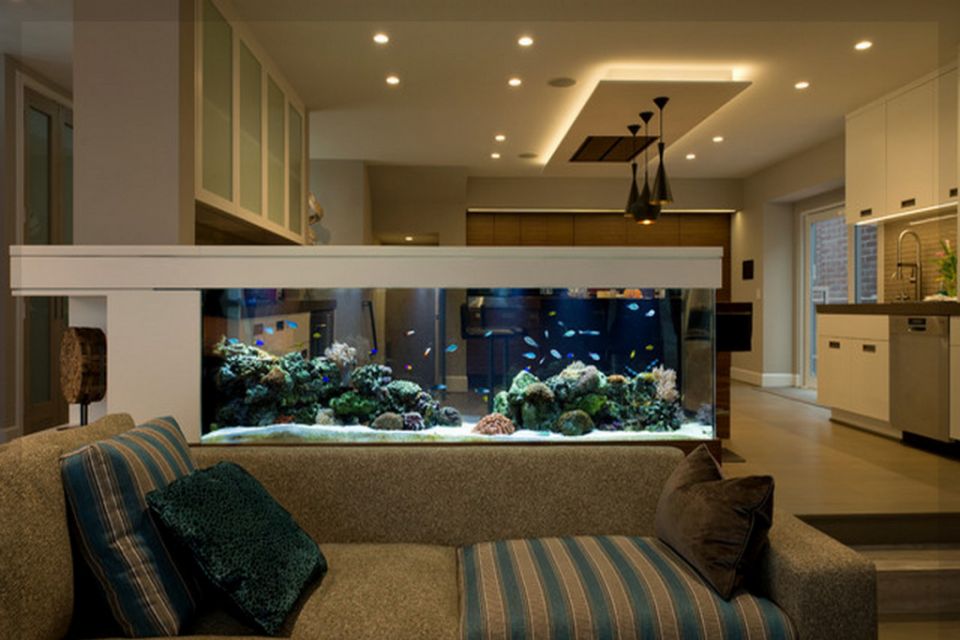
The sparking tetra is one of the most popular aquarium fishes in many respects. Their interesting behaviour and their splendid orange-red colouring create a very beautiful colour mood especially in South American aquarium. How you can keep the mini schooling fish from South America in your aquarium, which water qualities it prefers and how to breed it, we will tell you in the following article.
Table of Contents
Ember Tetra – Information at a glance
the Ember Tetra is a South American tetra, that is counted to the family of the so-called real tetras (Characidae). It grows to just 3 centimetres and is perfect for keeping in small aquaria. Some aquarists even keep these animals in nano aquariums.
The small Ember tetra especially like to live in aquariums with large-leaved border planting, which provides protection and shade. To satisfy their balanced swimming instinct Ember Tetra need enough swimming space.

The ideal water temperature for these characins is between 22°and 28° degrees Celsius. The aquarium should have a soft to medium hardness and a pH value of 5.5-7.5.
Since the small Ember tetra are very peace-loving, their socialization is also very uncomplicated. The Ember Tetra males form territories during their reproductive period, which they defend, but apart from that no aggressive behaviour can be observed in the Spark Tetra. If danger threatens, the Ember Tetras warm contracts.
The breeding of the animals is generally described as difficult. Breeding successes are rarely celebrated in the community tank.

How many Ember Tetra keep in the aquarium?
In the following table we show the optimal amount of fire tetra for a certain aquarium size. Please note that the amount of animals depends on the remaining stock, but also on many other factors such as decoration, planting or the available swimming space. More information about this can be found in our guidebook article about stocking densities/stocks in the aquarium.
| Basin size | Quantity of fire tetra |
| 60-80 litres | 8-12 animals |
| 100-120 litres | 12-15 animals |
| 180-240 litres | 20-30 animals |
| 350-450 litres | 30-40 animals |
The Ember Tetra are peaceful schooling fish, which should be kept in groups. At least one group of eight to ten fish should be maintained. In order to be able to reproduce its distinctive swarm behaviour in the aquarium, it is recommended to keep sparking tetras in larger 180-240 litre tanks. So you can admire this swarm behaviour with a group of 25-30 animals. If there are too few animals in the aquarium, you can easily recognize this by the fact that the fish do not swim around in a swarm, but individually in the tank.

What should the aquarium for Ember Tetra look like?
Thanks to their small size, sparking tetras can be kept in an aquarium from an edge length of 60 centimetres – this corresponds to a classic 60 litre aquarium. Whether Ember Tetra can generally be kept in an aquarium does not depend on the tank volume, but on the edge length. The beautiful ornamental fish need enough free swimming space, which is why keeping them in a smaller 60 litre nano aquarium (30 centimetres edge length) is only of limited use.

Ember Tetra feel particularly well in heavily planted aquariums. However, the tank should offer a balanced combination of decoration, plants and swimming area. Ember Tetra like dense border planting and need some decoration, like roots or stones, to hide. Nevertheless, the pool must have a sufficiently large swimming area to satisfy the animals’ swimming instincts.
A dark substrate is not only beneficial to the colourfulness of the animals, but is also found in the natural distribution area of the animals and should therefore be used especially in species tanks.

The Ember tetra is a very calm, small tetra that can be socialized with most common ornamental fish without problems. Ember Tetra mark their territories during the mating season, but they are not particularly aggressive and are therefore perfect for stocking in small aquariums. Thanks to their small size, however, especially in larger aquariums, care should be taken to ensure that fire tetra are not socialized with oversized ornamental fish, as otherwise they will end up as expensive live food.

How old does Ember Tetra get?
With good and species-appropriate care Ember Tetra can reach an age of six to ten years in the aquarium. Although the animals are not particularly susceptible to diseases and are not the most demanding aquarium inhabitants in terms of water quality, the animals will nevertheless grow considerably older if a species-appropriate tank is provided.

Which water qualities do Ember Tetras prefer?
Like the majority of tetra species available in pet shops, the fire tetra feels particularly comfortable in the following water conditions:
| Total hardness | 2-12° dHG |
| Carbonate hardness | 2-8° dKH |
| pH value | 5,5-7,5 |
| Temperature | 23-29° Celsius |
The water should have a total hardness of 2-12 ° dGH and a pH value of 5.5-7.5. In order to get particularly close to its home, the ideal water temperature should be between 23 and 29 degrees Celsius.

The sex differences in sparking tetra
Sex differences are not uniformly pronounced in the tetra groups. Especially in the sparking tetras the males hardly differ from the females. So only small differences in size and colouring of the animals can be observed. The males are a little smaller and a little slimmer than the females, the females are a little more inconspicuously coloured. Nevertheless these differences are not easily noticeable, so it can easily happen that a male is mistaken for a female.

What do you feed a Ember tetra?
The South American omnivores like small foods, such as Brine shrimp, Cyclops, or dry food (preferably flake food). As with all ornamental fish, the fire tetra should also be fed a varied diet. Regular feeding with live and frozen food contributes significantly to the colourfulness of the fish. Feeding live food also brings out the natural hunting instinct of the sparking tetra and awakens interesting behaviour.

Origin of the spark tetra
The natural distribution area of the Ember Tetrais located in the Araguaia river basin in the Brazilian region of Mato Grosso. These waters are characterised by particularly soft and acidic peat-filtered water. It is only in such water that the intense colour of the Ember Tetra can be seen. In aquariums with hard, alkaline water, these fish would wither away and would also not become very old. It is therefore all the more important to reproduce these natural conditions in order to maintain the colourfulness of the animals in their own aquarium.

Breeding Ember Tetras – something for true connoisseurs
The breeding of Ember Tetra is generally described as a very difficult task. Who wants to try it anyway or has already gained experience in the field, has to use a tank with a volume of about 40 litres and a height of about 30 cm as breeding tank. The water must be soft (below 5° dGH), have a pH value of about 5.6-6.5 and be clear. The aquarium should be densely planted with finely divided aquatic plants, such as java moss. In addition, the breeding tank should be optimally housed with a fire tetra pair or, as an alternative, with a male and two to three females. In the case of sparking tetras, this is done by spawning in open water. This produces 10 to 100 eggs. After spawning, the parent animals should be removed from the tank, as they are known as spawning predators. Alternatively, the breeding tank can be equipped with a so-called special spawning grid. The larvae need a temperature of 22-24° – this is the only way that they will succeed in hatching. This happens after one or two days. After another three to four days the small ornamental fish will swim freely. The agile young fish can initially be fed with dust-feed or with freshly hatched Brine shrimp. Afterwards feeding with Cyclops is recommended. To breed the Feuertetra, low-nitrate water is an absolute and indispensable must. Breeding these fish is considered difficult.

Conclusion: Keep Ember Tetras in the aquarium
Ember tetra are small, especially splendid South American Characidae. Thanks to their small size of just 3 centimetres when fully grown and their particularly calm and peaceful behaviour, they are perfectly suited for keeping in small aquarium and are therefore very popular.
If you stick to your low water quality requirements and provide a tank with a well-balanced combination of edge planting, hiding places and free swimming space, you can be happy about a robust schooling fish for small aquariums and make particularly beautiful stocking combinations a reality.
You already maintain Ember Tetra in the aquarium? Write us in the comments with which fish you keep them and what experiences you have made with the lively Characidae in general.



